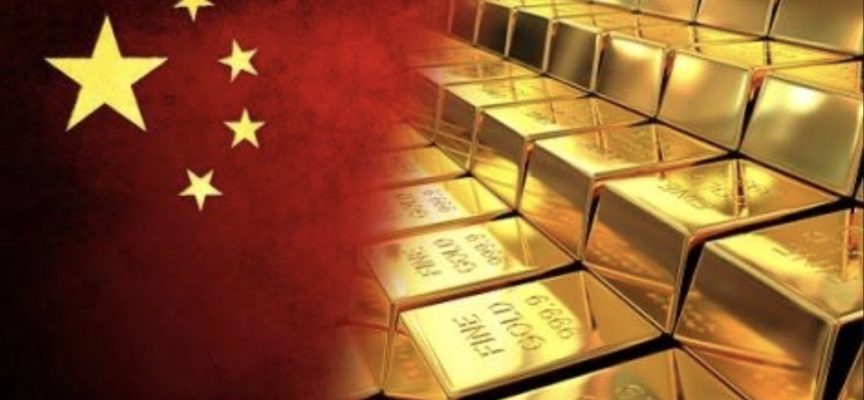As we kickoff the new year, the biggest surprise will be that China is going to replace the dollar with a gold-backed currency in 2018.
January 7 (King World News) – Dr. Stephen Leeb: “The year 2017 was full of sound and fury. Historians are sure to have a field day, with an endless stream of head-spinning headlines to pick from to launch their investigations. But as always, sometimes the most important stories – the ones that will likely have the biggest impact on the future – get largely overlooked. Or if they get attention, their true significance is missed.
As we begin 2018, it seemed worthwhile to look back at 2017 to list the items that caught my eye as having particular resonance and to explain how I interpreted them. I’ve reported on many of them previously, but I think they take on new relevance when viewed as a whole. Am I cherry picking? Yes, of course, to some degree. But I think that from a future vantage point it will be clear that the most significant overarching development this decade was a broad shift in power from West to East. The shift is already underway, but the following items are warning signs that it will only accelerate.
Many of these signs point to the near certainty that China will succeed in its pursuit of a new monetary system backed by gold – helping explain why I’m convinced gold is on the threshold of a massive, unprecedented rise…
To hear which company investors & institutions around the globe are flocking to
that has one of the best gold & silver purchase & storage platforms
in the world click on the logo:

Sponsored
1) April’s Mar-a-Lago Trump-Xi Summit Meeting
This two-day event certainly didn’t take place under the radar. Even if it had been uneventful, this first meeting between the relatively new U.S. president – who on the campaign trail had ranted against China for its trade practices – and the powerful head of China would have been inherently dramatic. And as it turned out, it was anything but uneventful. As the leaders dined together on April 6, U.S. missiles were bombing an airport in Syria. Heightening the drama, North Korea had just tested a ballistic missile that landed in the Sea of Japan.
The significance:
While the missile attack on Syria was praised as a sign of U.S. resolve, I see more devious undercurrents at play. I don’t think it was a coincidence that both Syria and North Korea became front burner issues just as Trump and Xi were meeting. Rather, I think Russia had a hand in the Syrian chemical attack that provoked the U.S. response – note that the U.S. warned Russia of its missile attack on the airport before it happened. And I don’t believe North Korea would have acted without permission from China. It suggests coordination between Russia and China aimed at distracting Trump from raising trade issues with China – as indeed he didn’t.
2) Tesla’s Missed Targets
In October, Tesla revealed minuscule deliveries of its highly touted Model 3 electric vehicle, its most modestly priced model that supposedly would bring EVs within the reach of the masses. It managed to produce only a few hundred cars in the quarter, dramatically below what it had projected and nowhere near its 2018 target of 10,000 a week.
The significance:
Tesla’s production contrasts with China’s explosive growth in EV production. In November 2017, EV sales reached 84,000 units in China, more than nine times Tesla’s average monthly sales during the fourth quarter. This points to China’s ability to dominate new-energy-related industries, and at the heart of this is China’s dominance in supply chains and in the resources that EVs depend on, including lithium, graphite, and cobalt. It’s a further reminder that the U.S. tragically lags China in access to the critical natural resources that will be essential not just to our economy but to our military.
3) Trump’s November Visit to Beijing
The elaborate, obsequious pageantry that China staged for Trump masked the fact that the U.S. has seemingly dropped its prior insistence that China give up its encroachment onto islands in the South China Sea.
The significance:
This was a tacit recognition that China’s military is capable of defending these islands and more generally that China can’t be challenged in the East. This bears directly on China’s ability to launch an alternative reserve currency that will replace the dollar at least within the Eastern half of the globe. Why? Because a reserve currency has always gone hand in hand with military as well as economic might, and China clearly has the military resources to protect the territory in which the new reserve currency would hold sway.
4) M.I.T. Study on U.S. Shale
The study pointed to less potential that is generally believed for U.S. oil production from shale. It said the sweet spots already have been disproportionately drilled and fewer remain. This means obtaining oil from shale will become increasingly expensive and less productive.
The significance:
U.S. shale production has been critical in keeping oil supply able to meet demand. If production falters, oil prices, which already have firmed, will continue to strengthen, and other commodities will rise in their wake. Gold, whose role historically has been to serve as a currency in times of commodity scarcities, will rise even faster.
5) China’s Ban on Trading Cryptocurrencies
Over the summer China issued a policy forbidding its citizens from trading in any cryptocurrency, including Bitcoin. Chinese officials viewed the extreme volatility in Bitcoin and other cryptocurrencies as a potential bubble that could undermine the economy. Strikingly, however, it allowed the mining of cryptocurrencies to continue.
The significance
By permitting continued mining, China is letting miners gain valuable experience in creating the blockchains that are associated with cryptocurrencies. The motivation is that blockchains will be essential in facilitating a new gold-backed monetary system. Based on various statements by Chinese officials, I’ve thought for a long time that China’s ultimate intention is not to substitute the yuan for the dollar but rather to replace the dollar with a basket of currencies – such as the SDR – to which gold would be added. Such transactions would be immensely complex, and probably the only way to implement the system effectively would be to record all transactions on blockchains.
6) Chinese-Saudi Trade Recorded on Blockchains
In December, Bloomberg reported that sometime earlier China and Saudi Arabia had begun conducting some trade that was being recorded on blockchains.
The Significance
I see this as an initial experiment in bringing in blockchains to facilitate international trade, a vital step in creating a new reserve currency. It’s further confirmation of China’s intentions in this area.
7) Paper by the National Bureau of Economic Research (NBER)
NBER is a nonprofit Massachusetts-based organization. In the spring it published a paper that, based on data gleaned from satellite technology, focused on China’s economy in the fourth quarter of 2015. Its conclusion: while China had reported GDP growth of 6.8 percent for the quarter, that likely understated its actual growth. The study said 6.8 percent was the low end of a range whose high end was 10 percent, suggesting that a growth rate of around 8 percent was likelier than the 6.8 percent China had reported.
The significance:
The report buttresses my view that – contrary to the West’s belief that China fudges its data on the upside – China has often deliberately downplayed its strengths. I see this as a tactic to keep the West off its back while it proceeded sub rosa with plans to gain an even greater role on the global stage, particularly by replacing the dollar with a new reserve currency eventually tied to gold.
8) Bloomberg Study on Chinese Corporate Debt
In December, Bloomberg reported that a study of 4,000 major Chinese corporations showed debt levels had fallen dramatically in 2017. To assess the companies’ leverage, the study looked at the ratio of debt to EBITDA (earnings before interest, expenses, taxes, depreciation, and amortization). A ratio of 1 would mean that the cash a company nets before interest, expenses, taxes, etc. equals the company’s entire debt load. Such a company offers great safety – it’s nearly inconceivable it could go bankrupt. After a decade in which the ratio for the 4,000 companies oscillated around 2, it dropped sharply in 2017 to 1.
The significance:
The Western world has long believed China has a major corporate debt problem. But in fact, if it ever did – and there’s evidence that in line with downplaying its strengths (see above) China overstated its debt problems – it no longer does. This means China is free to generate rapid growth, including by going all out with infrastructure creation within its borders and in the developing world at large. That will spur global growth and will mean rising demand for commodities, which in turn will be good for gold. And it leaves China strongly positioned to move ahead with its plans for a new monetary system.

9) Confirmation China Will Start Trading an Oil Benchmark in January in the Shanghai Free Trade Zone
This event actually didn’t happen in 2017 – Bloomberg reported it four seconds after midnight on Jan. 1, 2018 – but I’ll cheat by four seconds.
The significance:
I’ve long predicted that an initial step on China’s path to a reserve currency underpinned by gold would be China’s launching of an Eastern oil benchmark. It would begin by being traded in yuan – supplanting the dollar as the currency for oil trading – moving to trade in yuan backed by gold and then to a basket of currencies that includes both the yuan and gold. Trading on an oil benchmark in the Shanghai free zone is enormously significant because traders within that zone are permitted, in contrast to elsewhere in China, to take gold out of the country. It’s perhaps the clearest sign that China is moving quickly to free itself of the dollar.” ***King World News has now released the timely and powerful audio interview with James Turk, where he discusses exactly how he expects gold and silver to perform in 2018 as well as the mining shares, US dollar, cryptocurrencies and much more CLICK HERE OR ON THE IMAGE BELOW.
***ALSO JUST RELEASED: BULL MARKET SIGNAL: James Turk Says Gold & Silver Markets Extremely Well Bid To Start 2018 CLICK HERE.
© 2018 by King World News®. All Rights Reserved. This material may not be published, broadcast, rewritten, or redistributed. However, linking directly to the articles is permitted and encouraged.







